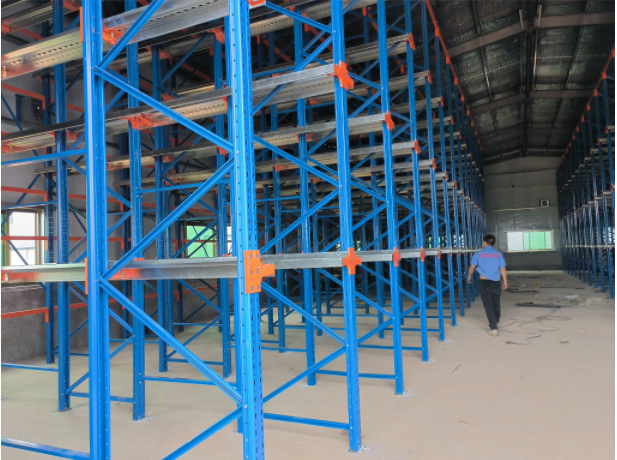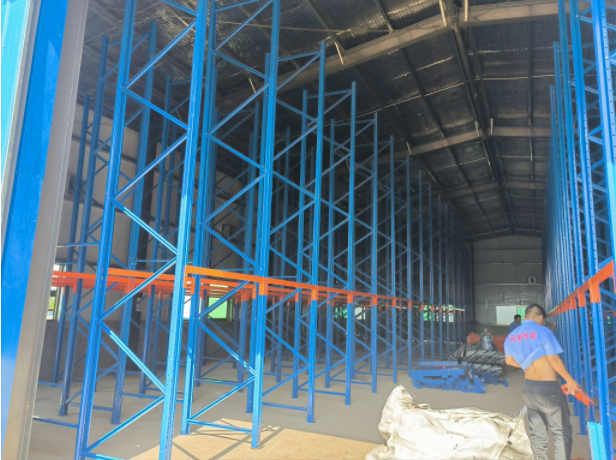In today's fast-paced industrial landscape, efficient storage is the backbone of any successful warehouse or distribution center. If you're dealing with soaring inventory levels and limited space, you've likely heard about large pallet racking as a game-changer. But what exactly is it, and why is it becoming a staple in modern facilities? Large pallet racking isn't just about stacking goods higher; it's a strategic system designed to maximize vertical space, streamline operations, and reduce costs. Whether you're in manufacturing, logistics, or retail, understanding how large pallet racking can transform your storage approach is crucial. This article dives deep into its core aspects, from design and benefits to safety and installation, providing you with actionable insights to optimize your warehouse. Let's explore how this robust storage solution can address common challenges and drive productivity to new heights.

Large pallet racking is a heavy-duty storage system specifically engineered to handle substantial loads and maximize space in industrial environments. At its core, it consists of upright frames, beams, and pallet supports that create multiple levels for storing palletized goods. This system is ideal for facilities dealing with high-volume inventory, such as warehouses, distribution centers, and manufacturing plants. Unlike smaller shelving units, large pallet racking is built to withstand significant weight—often supporting thousands of pounds per level—and allows for easy access to items through various configurations. The versatility of large pallet racking means it can be customized to fit different pallet sizes and load requirements, making it a flexible solution for diverse industries. By utilizing vertical space, it helps businesses avoid costly expansions and improve inventory management. In essence, large pallet racking serves as the foundation for an organized, efficient storage operation that adapts to growing demands.
When it comes to large pallet racking, there isn't a one-size-fits-all solution. Different types cater to specific storage needs, load capacities, and operational workflows. Understanding these variations can help you choose the right system for your facility. One common type is selective pallet racking, which allows direct access to every pallet, making it perfect for environments with high SKU variety and frequent item retrieval. Another popular option is drive-in or drive-through racking, where forklifts can drive into the structure to store and retrieve loads. This design is excellent for high-density storage of homogeneous products, though it may reduce accessibility. For even greater space utilization, push-back racking systems use a series of nested carts that allow pallets to be stored deeper, with each new load pushing the previous one back. This is ideal for last-in, first-out (LIFO) inventory management. Additionally, pallet flow racking incorporates dynamic elements like rollers or wheels to automatically move pallets from the loading to the unloading end, ensuring efficient stock rotation in high-throughput settings. Each type of large pallet racking offers unique advantages, so assessing your inventory turnover, space constraints, and handling equipment is key to making an informed decision.
Integrating large pallet racking into your storage strategy brings a host of benefits that directly impact efficiency and profitability. First and foremost, it maximizes vertical space utilization, allowing you to store more goods without expanding your facility's footprint. This is particularly valuable in urban areas where real estate costs are high. Moreover, large pallet racking enhances inventory organization, reducing the time workers spend searching for items and minimizing errors in order fulfillment. By providing clear aisles and accessible storage levels, it improves workflow efficiency and supports faster loading and unloading processes. Safety is another significant advantage; these systems are designed with sturdy materials and can include features like guardrails and load locks to prevent accidents and damage to goods. From a financial perspective, large pallet racking offers a strong return on investment by lowering operational costs through reduced labor hours and better space management. It also scales with your business, as modular designs allow for easy reconfiguration or expansion as needs evolve. Overall, the benefits of large pallet racking make it an indispensable tool for modern warehouses aiming to stay competitive.

Proper installation and maintenance are critical to getting the most out of your large pallet racking system. Installation typically begins with a thorough site assessment to ensure the floor can support the load and that the layout aligns with your operational flow. It's advisable to work with professional installers who follow industry standards, such as those set by the Rack Manufacturers Institute (RMI), to guarantee structural integrity. Key steps include assembling upright frames, securing beams at appropriate heights, and installing safety accessories like row spacers and shims. Once installed, regular maintenance is essential to prolong the system's lifespan and prevent failures. This involves routine inspections for signs of damage, such as bent beams or loose connections, and immediate repairs to avoid cascading issues. Cleaning the racking to remove debris and monitoring load weights to prevent overloading are also crucial. Additionally, training staff on proper usage—like avoiding impacts from forklifts—can minimize wear and tear. By adhering to these best practices, you'll ensure that your large pallet racking remains reliable and safe, supporting your operations for years to come.
Safety should always be a top priority when dealing with large pallet racking, as failures can lead to serious injuries, product loss, and downtime. Start by ensuring that the racking is designed and installed to handle the intended loads, with clear weight limits displayed on each section. Regular inspections are vital; look for issues like corrosion, deformation, or missing components, and address them promptly. It's also important to implement proper labeling and signage to guide operators on safe practices, such as not exceeding height restrictions or climbing on the racking. Incorporating safety features like column guards, aisle markers, and anti-collapse mesh can further reduce risks. Employee training plays a key role here—workers should be educated on how to load and unload pallets evenly, use equipment like forklifts correctly, and report any hazards immediately. Additionally, consider conducting periodic safety audits and adhering to local regulations to maintain compliance. By prioritizing these measures, you can create a secure environment that leverages the full potential of large pallet racking without compromising well-being.
Large pallet racking is incredibly versatile, finding applications across a wide range of industries due to its ability to handle diverse storage needs. In the retail sector, it supports bulk storage of goods in distribution centers, enabling quick restocking and efficient order processing. Manufacturing plants use large pallet racking to store raw materials and finished products, streamlining production lines and reducing clutter. The logistics and transportation industry relies on it for sorting and temporary storage in hubs, facilitating smooth supply chain operations. Even in sectors like agriculture or automotive, where items can be heavy and irregularly shaped, large pallet racking provides a sturdy solution for organizing tools, parts, and equipment. Furthermore, cold storage facilities benefit from its durability in low-temperature environments, ensuring that perishable goods are stored safely. By adapting to specific industry requirements—such as humidity resistance or custom dimensions—large pallet racking proves to be a universal asset that enhances efficiency and supports growth in virtually any setting.
Q1: What is the average lifespan of large pallet racking systems?
A1: The lifespan of large pallet racking systems typically ranges from 10 to 20 years, depending on factors like usage intensity, maintenance practices, and environmental conditions. Regular inspections and prompt repairs can extend this duration significantly.
Q2: How do I determine the right type of large pallet racking for my warehouse?
A2: To choose the appropriate large pallet racking, consider your inventory characteristics (e.g., pallet size, weight, and turnover rate), available space, and operational workflow. Consulting with a storage solutions expert can help tailor the system to your specific needs.
Q3: Can large pallet racking be reconfigured if my storage needs change?
A3: Yes, one of the key advantages of large pallet racking is its modular design, which allows for easy reconfiguration. Beams and frames can often be adjusted or relocated to accommodate changes in inventory or layout.
Q4: What are the common safety risks associated with large pallet racking?
A4: Common risks include overloading, forklift collisions, and improper installation, which can lead to collapses or falls. Mitigate these by adhering to load limits, installing protective features, and providing thorough staff training.
Q5: How does large pallet racking compare to other storage solutions in terms of cost?
A5: Large pallet racking is generally cost-effective due to its durability and space-saving benefits, though initial costs vary based on type and scale. It often offers a better long-term return compared to alternatives like static shelving by reducing the need for additional space and improving efficiency.
In conclusion, large pallet racking is more than just a storage option—it's a strategic investment that can revolutionize how you manage space and inventory. By understanding its types, benefits, and best practices, you can harness its potential to drive efficiency and safety in your operations. If you're considering an upgrade, start by assessing your needs and exploring the versatile world of large pallet racking.
 Wechat
Wechat
 Whatsapp
Whatsapp